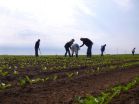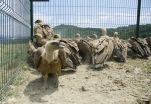(Press-News.org) Using nature for inspiration, a team of Northwestern University scientists is the first to develop an entirely artificial molecular pump, in which molecules pump other molecules. This tiny machine is no small feat. The pump one day might be used to power other molecular machines, such as artificial muscles.
The new machine mimics the pumping mechanism of life-sustaining proteins that move small molecules around living cells to metabolize and store energy from food. For its food, the artificial pump draws power from chemical reactions, driving molecules step-by-step from a low-energy state to a high-energy state -- far away from equilibrium.
While nature has had billions of years to perfect its complex molecular machinery, modern science is only beginning to scratch the surface of what might be possible in tomorrow's world.
"Our molecular pump is radical chemistry -- an ingenious way of transferring energy from molecule to molecule, the way nature does," said Sir Fraser Stoddart, the senior author of the study. Stoddart is the Board of Trustees Professor of Chemistry in Northwestern's Weinberg College of Arts and Sciences.
"All living organisms, including humans, must continuously transport and redistribute molecules around their cells, using vital carrier proteins," he said. "We are trying to recreate the actions of these proteins using relatively simple small molecules we make in the laboratory."
Details of the artificial molecular pump were published May 18 by the journal Nature Nanotechnology.
Chuyang Cheng, a fourth-year graduate student in Stoddart's laboratory and first author of the paper, has spent his Ph.D. studies researching molecules that mimic nature's biochemical machinery. He first designed an artificial pump two years ago, but it required more than a year of testing prototypes before he found the ideal chemical structure.
"In some respects, we are asking the molecules to behave in a way that they would not do normally," Cheng said. "It is much like trying to push two magnets together. The ring-shaped molecules we work with repel one another under normal circumstances. The artificial pump is able to syphon off some of the energy that changes hands during a chemical reaction and uses it to push the rings together."
The tiny molecular machine threads the rings around a nanoscopic chain -- a sort of axle -- and squeezes the rings together, with only a few nanometers separating them. At present, the artificial molecular pump is able to force only two rings together, but the researchers believe it won't be long before they can extend its operation to tens of rings and store more energy.
Stoddart's team has been researching artificial molecular machines for several years. A challenge they have faced for a long time is how to power their machines. This latest advance may allow them to make machines that perform tasks at the molecular level.
Compared to nature's system, the artificial pump is very simple, but it is a start, the researchers say. They have designed a novel system, using kinetic barriers, that allows molecules to flow "uphill" energetically.
"This is non-equilibrium chemistry, moving molecules far away from their minimum energy state, which is essential to life," said Paul R. McGonigal, an author of the study. "Conducting non-equilibrium chemistry in this way, with simple artificial molecules, is one of the major challenges for science in the 21st century."
Ultimately, they intend to use the energy stored in their pump to power artificial muscles and other molecular machines. The researchers also hope their design will inspire other chemists working in non-equilibrium chemistry.
"This is completely unlike the process of designing the machinery we are used to seeing in everyday life," Stoddart said. "In a way, one must learn to see things from the molecules' point of view, considering forces such as random thermal motion that one would never consider when building an agricultural water pump or any other mechanical device."
INFORMATION:
The title of the paper is "An Artificial Molecular Pump." In addition to Stoddart, Cheng and McGonigal, other authors of the paper are Severin T. Schneebeli, Hao Li, Nicolaas A. Vermeulen and Chenfeng Ke, all of Northwestern.
JACKSONVILLE, Fla. -- Patients with liver cancer can be cured with a liver transplant. But because of the shortage of donated organs, these patients often die waiting for a liver. That's because most transplant centers predominantly use livers from donors who die from brain death.
But in the largest study of its kind, transplant physicians at Mayo Clinic in Florida have found that liver cancer patients have the same beneficial outcomes using organs donated by patients who died of cardiac death. The study was recently published online in the American Journal of Transplantation.
MULTIMEDIA ...
(New York, May 19, 2015) -- The largest urban health systems, which serve as safety nets for large patient populations with lower socioeconomic status and greater likelihood to speak English as a second language, do worse on government patient satisfaction scores than smaller, non-urban hospitals likely to serve white customers with higher education levels, according to a new study by Mount Sinai researchers published this month in the Journal of Hospital Medicine.
Patient satisfaction scores, in part due to the Affordable Care Act of 2010, are a key part of the formula ...
ANN ARBOR--A class of FDA-approved cancer drugs may be able to prevent problems with brain cell development associated with disorders including Down syndrome and Fragile X syndrome, researchers at the University of Michigan Life Sciences Institute have found.
The researchers' proof-of-concept study using fruit fly models of brain dysfunction was published today in the journal eLife. They show that giving the leukemia drugs nilotinib or bafetinib to fly larvae with the equivalent of Fragile X prevented the wild overgrowth of neuron endings associated with the disorder. ...
For the patient, surgery involves extreme physical stress, and in older patients especially this can lead to disorders of consciousness or cognition. The acute confusional state known as delirium, however, can often be prevented by specialist nursing care after the operation, as Torsten Kratz and co-authors show in an original article in the current issue of Deutsches Ärzteblatt International (Dtsch Arztebl Int 2015; 112: 289-96). In their study delirium liaison nurses were employed to help care for surgical patients aged 70 years and over. In every patient, the risk ...
Preschoolers already recognize what it feels like to be left out when goodies are being shared. In a new study, Researchers at Ludwig-Maximilians-Universitaet (LMU) in Munich show that 3-year-olds can anticipate negative feelings in others, and adjust their own behavior in response.
Why are we willing to share with others what we could just as well keep for ourselves? Willingness to allot a portion of a coveted resource to someone else is a behavioral pattern that can throw light on the origins and development of prosocial modes of response during childhood. In a new ...
TAMPA, Fla. -- Cells within a tumor are not the same; they may have different genetic mutations and different characteristics during growth and throughout treatment. These differences make treating tumors extremely difficult and often lead to tumor recurrence dominated by more aggressive tumor cells. Moffitt Cancer Center researchers are using mathematical modeling to characterize these differences within a tumor and hope that the results of their latest study will lead to better therapeutic treatments.
"Many tumors exhibit different metabolic behaviors compared to normal ...
Researchers at the University of Warwick have found a significant link between the presence of persistent nightmares in childhood and psychotic experiences in later adolescence.
In a new paper published in the British Journal of Psychiatry, a team based at the Division of Mental Health and Wellbeing at Warwick Medical School at the University of Warwick found that persistent childhood nightmares both at an early age (between 2 and 9) and at age 12 were significantly associated with new incidences of suspected or definite psychotic experiences at age 18.
The University ...
Escherichia coli O104 is an emergent disease-causing bacterium various strains of which are becoming increasingly well known and troublesome. The pathogen causes bloody diarrhea as well as and potentially fatal kidney damage, hemolytic uremic syndrome. Infection is usually through inadvertent ingestion of contaminated and incompletely cooked food or other materials, such as animals feces.
Escherichia coli is a so-called gram negative bacterium, commonly found in the intestine of humans and other mammals. Entero-hemorrhagic strains including O157, O26, O103 and O111 and ...
The fungi (Rhizoctonia solani) is stealthy blight, becoming visible only shortly before the harvest infesting beets or corn at their roots. The fungal rot begins early in the season, working its way from the inside out, and only becoming visible in the fall, destroying the possibility of a harvest. Year after year crop failures due to attacks by pests and pathogens are reported in the media despite their being treated with pesticides. Crop failure is further exacerbated by pesticide treatments which cause the death of insects such as bees through neonicotinoids. "There ...
Because of their position on the food chain and their dietary habits, Griffon vultures from the Iberian Peninsula are exposed to accumulation of heavy metals in their tissues. A study benefiting from the participation of the Autonomous University of Barcelona reveals that, due to their diets, wild populations of Griffon vultures in Catalonia show the presence of a high amount of lead, which affects their immune systems and reproductive function.
The population of wild birds is subject to the dangers resulting from the presence of toxic elements in the environment. Even ...

